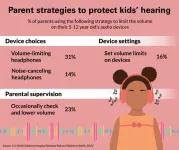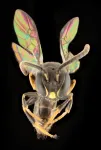(Press-News.org) In 2023, Rhode Island, Massachusetts and Minnesota joined a growing list of states that allow undocumented immigrants to obtain driver’s licenses if an applicant can provide certain documentation, such as a foreign birth certificate or passport and evidence of current residency in the state. Altogether, 19 states and the District of Columbia have similar legislation in place. And lawmakers in other states, such as Michigan and Oklahoma, have introduced similar legislation.
In many cases, these laws were passed based on the premise that they would keep the roads safer by allowing undocumented immigrants to drive legally and obtain insurance. But new research from Washington University in St. Louis provides evidence that these laws also indirectly improve the overall health and well-being of immigrant mothers and their babies.
The research, published Feb. 26 in the Journal of Health and Social Behavior, found that implementing license laws is associated with improvements in birth weight — a critical measure of early development with long-term health implications — for babies born to Mexican and Central American immigrants.
The authors also noted a decline in preterm birth rates between 2008-2021 in states that enacted license laws compared with those that did not, though rates in both groups declined over time.
“Our study’s findings underscore how states’ extension of legal rights to immigrants can improve the health of the next generation,” said Margot Moinester, study co-author and an assistant professor of sociology in Arts & Sciences at WashU.
“Previous research has demonstrated that restrictive immigration policies and practices contribute to poor health outcomes for immigrant families, but our study is among the first to demonstrate a positive relationship between inclusive immigration policies and improved health.”
Connecting the dots
To study the connection between license laws and birth outcomes, Moinester and co-author Kaitlyn K. Stanhope, at Emory University, examined birth records for more than 4 million singleton births born to Mexican and Central American immigrants between 2008-2021 living in states that adopted these laws during the study period. They also tracked how many months prior to conception the law was implemented to assess how the relationship between the implementation of a license law and changes in perinatal health — that of pregnant people and their babies before, during and after birth — over time.
Finally, as a control measure, they compared their findings with outcomes for U.S.-born, non-Hispanic white pregnant people living in these states, but found no correlation between the implementation of a license law and birth weight in this population.
The research established a correlation between these laws and improved birth outcomes among babies born to Mexican and Central American immigrants, but stopped short of explaining why the correlation exists. According to Moinester and Stanhope, these laws likely influence perinatal health by lessening deportation fears and stress. It’s well known that stress prior to and during pregnancy can increase risk of adverse birth outcomes, including low birth weight and preterm birth.
“By reducing the criminalization of immigrants, driver’s license laws may lessen deportation fears and subsequent stress, potentially improving birth outcomes,” Stanhope said.
Because stress prior to conception — not just during pregnancy — can affect birth outcomes, it’s likely that the strength of the association would increase over time, she added.
“While we see stress as one key mechanism through which these license laws may improve perinatal health, we also think it is possible that the laws could lead to improved birth outcomes by increasing immigrants’ access to financial resources, including better-paying jobs and more weekly work hours,” Moinester said.
The authors also hypothesized that the laws would improve immigrants’ perinatal health by making it easier to access timely prenatal care. However, contrary to their hypothesis, they observed a slightly lower probability of first-trimester entry into care for individuals in states with license laws. According to the authors, one possible explanation could be that immigrants living in these states already had high rates of early prenatal care, meaning there was little room for improvement. Another possible explanation could be that access to a driver’s license was not enough to counteract other barriers, such as a lack of insurance, language differences and distance to care.
Changing immigration landscape
Over the past two decades, states have emerged as important players in the immigration policy arena, passing immigration legislation at a scale not seen in over a century, the authors said.
“There’s been a lot of focus on the extreme measures taken by some states to keep immigrants out and limit their access to services and benefits, but many states have responded by affirming their support for immigrants,” Moinester said.
“In fact, more than half of the states that have enacted license laws did so after 2015, when Donald Trump began his first campaign and made immigration enforcement a key issue.”
According to Moinester, the findings from this study highlight the potential of an individual state policy to positively shape the lives of Mexican and Central American immigrants and their children amid a highly conflictual federal and state immigration policy climate.
Because government-issued IDs are required to access a range of economic and material resources critical to health, including bank accounts, utilities, prescription medications, housing and safety net programs — plus more job opportunities — it’s likely these laws have other important health implications, Moinester said. More research is needed to better understand the health implications of these policies and to inform future policy decisions.
END
Birth outcomes improve in states that extend driver’s licenses to undocumented immigrants, research finds
2024-02-26
ELSE PRESS RELEASES FROM THIS DATE:
First-in-humans discovery reveals brain chemicals at work influencing social behavior
2024-02-26
In a study in today’s (Monday Feb. 26) Nature Human Behavior, scientists delve into the world of chemical neuromodulators in the human brain, specifically dopamine and serotonin, to reveal their role in social behavior.
The research, conducted in Parkinson's disease patients undergoing brain surgery while awake, homed in on the brain’s substantia nigra, a crucial area associated with motor control and reward processing.
Led by Virginia Tech computational neuroscientist Read Montague, the international team revealed ...
Shifting focus: Investigators describe changes to pancreatic β cell at onset of Type 1 Diabetes
2024-02-26
BOSTON – About eight million people live with Type 1 diabetes (T1D) worldwide, a chronic autoimmune condition in which the body attacks and destroys its own insulin-producing β-cells (pronounced “beta”) in the pancreas, leading to a lack of insulin and inability to regulate blood sugar. It’s not known why the body suddenly perceives its own β-cells as the enemy; some lines of evidence suggest environmental factors such as viral infections may trigger the onset of T1D, others suggest genetics may also play some role.
Groundbreaking ...
Award-winning researcher dreams of stellar explosions and strives for equity and inclusion in academia
2024-02-26
She studies the giant explosions of dying stars and dreams of experiencing and extracting data from a supernova close to Earth. Professor Irene Tamborra from the Niels Bohr Institute also tirelessly promotes equity and inclusion in research. Today she receives the prestigious Elite Research Prize and DKK 1.2 million in honor of her research in astrophysics.
"I am fascinated by anything that explodes in the sky," Professor Irene Tamborra says as she begins to describe her research. The professor from the University of Copenhagen’s ...
Clinical trial tests combination antibody therapy in adults with advanced cancer
2024-02-26
In an early phase clinical trial, a combination of antibody-based medications targeting the immune system generated promising safety data and anti-tumor activity in individuals with various types of advanced cancer. The findings are published by Wiley online in CANCER, a peer-reviewed journal of the American Cancer Society.
Both medications tested in the trial support immune responses against tumor cells. CS1002 increases the activation and proliferation of T immune cells by binding to a T cell receptor called CTLA-4. CS1003, also called nofazinlimab, ...
Birds and bee lessons as Pacific field trips also solve 'Michener's mystery'
2024-02-26
Eight new Pacific bee species and new insights into Fijian bird behaviour on Viti Levu Island have been described in new scientific studies led by Flinders University.
The studies, both funded by field work supported by the Australian Government’s New Colombo Mobility Plan Program, highlight the potential for species discovery, ecological and conservation knowledge and cultural engagement from Asia-Pacific research collaborations.
In the past 10 years, Australian Government-funded Flinders University field trips have worked closely ...
Can they hear you now? Kids increasingly exposed to noise health risks via earbuds and headphones
2024-02-26
ANN ARBOR, Mich. – While it’s not surprising to spot teens wearing headphones and earbuds, it’s also becoming a widespread trend among younger children, a national poll suggests.
Two in three parents say their child ages 5-12 uses personal audio devices, with half of parents of children ages 5-8 reporting elementary-aged kids use a device.
Among parents whose children use headphones and earbuds, half say kids spend at least an hour a day using them while one in six say a typical ...
How did a tiny bee get to French Polynesia? Eight new species help solve a scientific mystery
2024-02-26
In 1934, American entomologist Elwood Zimmerman, then an undergraduate student at Berkeley, participated in the ‘Mangarevan expedition’ to Polynesia. Among the samples he collected were three tiny (4 mm long), orange-brown solitary bees found on tahetahe flowers in the Tuamotu Archipelago.
The specimens rested undisturbed in the Bernice P Bishop Museum of Honolulu until 1965, when the famous bee specialist Prof Charles Michener examined them. He described them as a species new to science: Hylaeus tuamotuensis, or Tuamotu’s masked bee, in the family ...
Many older adults receiving home care do not receive palliative care before death
2024-02-26
Many older adults receiving home care do not receive any palliative home care before death, suggesting we need better methods to identify people who need this support, according to new research in CMAJ (Canadian Medical Association Journal) https://www.cmaj.ca/lookup/doi/10.1503/cmaj.221513.
"Palliative care is an essential component of a holistic, comprehensive and patient-centred approach to care for all people with a life-limiting illness from the time of diagnosis with the disease," said Dr. Amy Hsu, investigator at the Bruyère Research Institute and faculty in the Department of Family Medicine at the ...
Reforestation schemes are not enough to recover the carbon created by harvesting wood, research suggests
2024-02-26
Forests have a critical role to play in capturing and storing carbon from the Earth’s atmosphere – but some models exaggerate their carbon removal potential by almost three-fold, according to a leading professor of forest economics.
Global Forest Carbon: Policy, Economics and Finance by Runsheng Yin from Michigan State University emphasizes the value of nature-based solutions to the climate crisis but calls for significant changes to the way carbon credits from reforestation, afforestation, and improved forest management are calculated. He has found that current modeling of local ...
Antidepressant dispensing to adolescents and young adults surges during pandemic
2024-02-26
Antidepressant dispensing to adolescents and young adults increased sharply after the COVID-19 pandemic began – particularly among females – a new study finds.
While a growing number of young people ages 12 to 25 were receiving antidepressants before the pandemic, the antidepressant dispensing rate rose nearly 64% faster after March 2020, according to Michigan Medicine led findings in Pediatrics.
“Antidepressant dispensing to adolescents and young adults was already high and rising before ...




